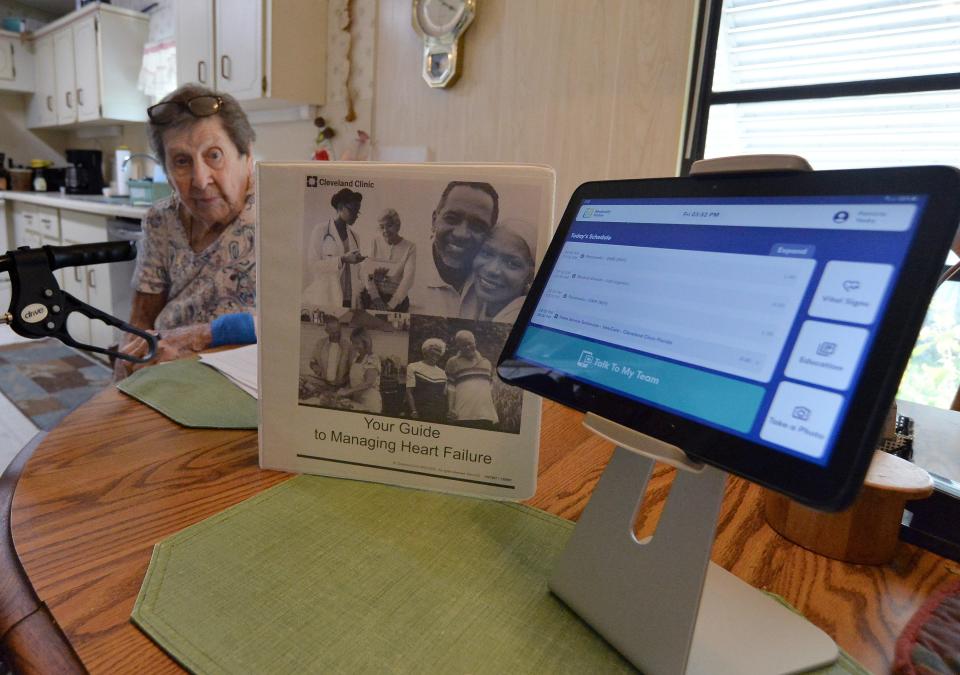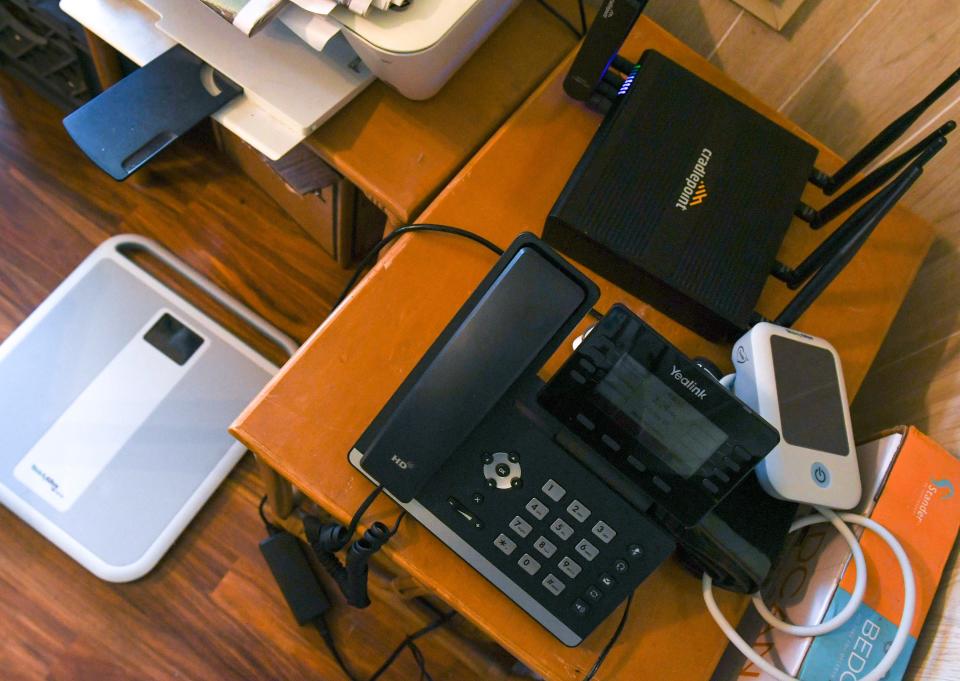‘Too good to be true’: Cleveland Clinic Indian River Hospital launches Care At Home program
For 10 days in June, Bob White savored the scent of jasmine and the sight of birds and butterflies flitting about his backyard garden. A white fence — not hospital walls — ensconced the patient in his Vero Beach oasis as he recovered from cellulitis.
Twice a day, a nurse or paramedic took his vitals and administered IV fluids. A courier delivered his medication like clockwork. Delivery drivers sometimes brought meals. A doctor consulted with him virtually at least every other day.
“It had all the amenities of being in a hospital, all the care of being in a hospital, only, I think, to a higher degree,” White said of Cleveland Clinic Indian River Hospital’s new Care At Home program. “It really is a godsend for people that don’t want to spend a lot of time in the hospital, but need that hospital care and hospital attention.”
White was among the first inpatients to receive acute care at home. The 64-year-old had gone to the emergency room for a bacterial skin infection, one of many complications from breaking his right foot in 2020. Instead of admitting White to a hospital room, Dr. Richard Rothman offered a proposition: Would he like to recover at home?
“They told me that by the time I got to my house that they would have everything set up for me,” White said. “I asked [Rothman] to repeat it, basically, because I was like, ‘This sounds too good to be true.’ ”
Reimagining acute care from Vero Beach
Since Care At Home launched in April, over 200 patients have been treated, according to Rothman, chief medical operations officer for Cleveland Clinic Florida.
The COVID-19 pandemic exacerbated challenges burdening hospitals — overcapacity, high costs and staff burnout — and sparked an urgency for change.
“There’s an opportunity to reimagine acute care delivery for patients that would otherwise require hospitalization,” Rothman said. “There’s also an opportunity to start to think about how we expand care beyond our geographic footprint, to provide services to patients that may not always come to the hospital.”
Patients must live within a 30-mile radius of Indian River Hospital, which extends as far north as Melbourne Beach, as far west as Yeehaw Junction and as far south as Jensen Beach. Cleveland Clinic plans to expand Care At Home to its other Treasure Coast hospitals by December, with similar radiuses for Tradition in Port St. Lucie, and Martin North and Martin South in Stuart.
Weston Hospital will be added in 2024. Even as the program expands south, its 24/7 situation room, dubbed the Clinically Integrated Virtual Care Center, will remain in Vero Beach.
When White got home from the hospital, tech staff already had assembled his medical equipment. He was given a phone, an emergency call button and a tablet that displayed a daily schedule of specialists who would be visiting or virtually consulting with him.
“They thought through all the pieces of how to make this successful … you feel immensely taken care of,” he said. “I couldn’t visualize it until I had actually experienced it.”
While White couldn’t get down in the dirt and tend to his beloved flowers during the remote hospital stay, he could at least heal with “nature all around me,” he said.
Home hospitalization’s Hopkins roots, COVID spike
Acute home care in the U.S. was pioneered by researchers at the Johns Hopkins University schools of Medicine and Public Health, whose trademarked Hospital at Home program began in the 1990s with 17 patients ages 65 and older who had sought treatment at the university’s Bayview Medical Center in Baltimore.
This pilot study proved to be “feasible, safe and cost-effective,” with patients having “comparable clinical outcomes to those treated in the acute hospital,” according to results published in the Journal of the American Geriatrics Society in 1999.
In the early 2000s, Hopkins successfully tested its approach at four hospitals nationwide, including a Veterans Affairs medical center. But only a handful of hospitals from Los Angeles to Philadelphia adopted Hospital at Home.
“Until COVID, telehealth was essentially non-billable … so there was no incentive to do telehealth,” said Steven Ullmann, director of the Center for Health Management and Policy at the University of Miami Herbert Business School. “There was no incentive to provide at-home acute hospital care because, similarly, the hospital could not bill.”
The Centers for Medicare and Medicaid Services made an exception when COVID-19 inundated hospitals, initiating the Acute Hospital Care at Home waiver in November 2020 that allowed Medicare-certified hospitals to provide residential inpatient care. Nearly 300 hospitals across 125 health systems in 37 states had been approved as of Aug. 24, 2023, including Cleveland Clinic Florida in September 2021.
The waiver is a “win win win,” Ullmann said. Less infrastructure means Medicare reimburses hospitals at lower rates, hospitals generate revenue while saving bed space and patients are more comfortable at home.
“We have not had traction yet with Medicaid,” Rothman said, adding private health insurance companies are supportive. “One of our hopes is to be able to deliver this care equitably across all patient populations, irrespective of payer.”
Health equity a goal of Care At Home
Patricia Yasky was feeling better, if a bit wistful, one September afternoon. The 92-year-old, who has Type 1 diabetes, sat at the kitchen table in her Fort Pierce home, having just been discharged from Care At Home.
The hypoglycemia, or low blood sugar, that had sent her to the ER four days earlier was under control, but she was missing her nurses, who affectionately called her “Miss Patty.”
“It was like saying goodbye to my friends,” she said. “They’ve made it so personal and so easy.”
Equipment provided by Medically Home, Care At Home’s logistics partner, awaited pickup: scale, phone, modem, blood pressure cuff, pulse oximeter and portable power supply. The technology was overwhelming for her at first, but she quickly embraced it, said her son Michael Yasky. The experience was preferable to recovering in the hospital, they agreed.

“If I was a billionaire, I couldn’t have gotten better treatment,” she said.
Care At Home aims to ease the burden on family and friends too, said nurse manager Danielle Crow. They don’t have to visit the patient in the hospital and can participate in virtual plan-of-care visits.
An ER or medical/surgical patient cannot request program placement. They are automatically evaluated if they are 18 or older and live in the service area. Common eligible conditions include pneumonia, heart failure, complex sepsis and chronic obstructive pulmonary disease. At minimum, a patient must have running water, electricity, toilet access, and either internet or a strong cellular signal. Living alone doesn’t preclude eligibility.
“When we look at a patient, the questions are: Is it medically necessary for them to be hospitalized? Can we deliver the medically necessary care in the home?” Rothman said. “If the answers to those two questions are yes, the next question is, socially, can a patient safely be at home?”

Though COVID-19 spurred home hospitalization’s widespread adoption, it’s here to stay, predicted Zachary Pruitt, an associate professor at the University of South Florida College of Public Health. He anticipates more conditions will be remotely treatable, and technology, including artificial intelligence, could fill gaps between inpatient and home care.
That won’t negate nursing shortages, and home hospitalization isn’t without problems. But as long as cost-cutting measures don’t compromise quality of care, the U.S. health care system is making progress, he said.
“This is going to seem like magic at first,” Pruitt said. “Eventually, we’ll become more comfortable with [home hospitalization] and its connectedness.”
Lindsey Leake is TCPalm’s projects reporter. She has an M.A. in Science Writing from Johns Hopkins University, an M.A. in Journalism and Digital Storytelling from American University and a B.A. from Princeton University. Follow her on X @NewsyLindsey, Facebook @LindseyMLeake and Instagram @newsylindsey. Call her at 772-529-5378 or email her at lindsey.leake@tcpalm.com.
Read more of Lindsey’s stories and support her work with a TCPalm subscription.
This article originally appeared on Treasure Coast Newspapers: Cleveland Clinic Indian River Hospital Care At Home from Vero Beach

